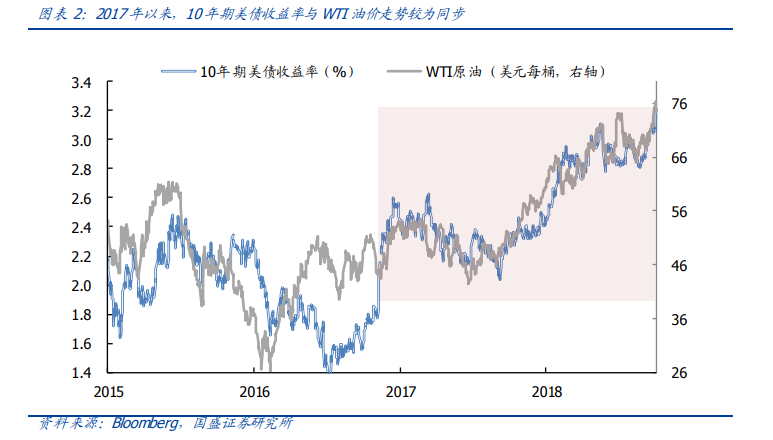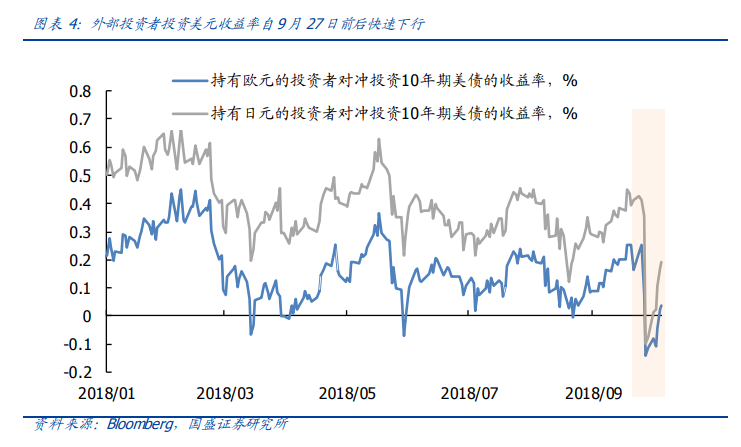Edited by Guosheng Securities: "the gradual upside-down interest rate spread between China and the United States-- written after the US debt broke 3.2%."
During the National Day holiday, the most eye-catching event in global capital markets was that the yield on US 10-year Treasuries climbed to 3.23 per cent, the highest since May 2011. In this regard, BoCom International Hongyi pointed out: for the first time in 30 years, ten-year US bond yields have exceeded the 200-month moving average. The last breakthrough was on the eve of Black Monday. Ten-year Treasury yields continued to climb, pushing the dollar up to 96. In contrast, emerging market currencies have been losing ground, and the Turkish lira and the Indian rupee have been bloodwashed again.
1. Federal Reserve Chairman Powell's speech triggered a sharp rise in US bond yields.
On October 3rd, Federal Reserve Chairman Powell said in his speech that the US economy is quite positive (remarkablypositive) and that there is no need to keep interest rates ultra-low and to shift gradually to neutral interest rates that are neither loose nor tight. 2 during the Powell speech of the Federal Reserve, both the dollar index and US bond yields rose significantly, and US debt rose by about 0.5% on the day. 10-year Treasury yields rose 11.8bp (this upward range was also partly attributed to the higher-than-expected ADP employment data released the night before).
On the face of it, the rapid rise in US bond yields is the direct impact of Federal Reserve Chairman Powell's speech on October 3, but careful analysis shows that Powell's speech may serve as a fuse. Rising inflation expectations and changes in the market trading structure have laid the foundation for the drastic adjustment of US debt.
2. One of the reasons for the sharp fluctuations in 10-year US debt: rising inflation expectations in the United States, two-wheel drive of the labor market and oil prices.
Strong labor market plus high oil prices push up inflation expectations in the United States. American inflation is greatly affected by two factors: on the one hand, the labor market affects core inflation, mainly reflected in the transmission of wage increases to consumer prices; on the other hand, the impact of oil prices on energy prices.
On the labour market, there are still upside risks for non-farm data pointing to core inflation.Non-farm job creation in September fell short of market expectations, but the U3 unemployment rate was as low as 3.7% and the U6 unemployment rate was also at a lower level of 7.5%, as well as a higher hourly wage increase of 0.3% from the previous month, pointing to the possibility that core inflation could still rise. Moreover, since the 2008 financial crisis, new jobs in the United States have been mainly concentrated in the middle and low-end service industries, where wage increases, especially in consumer services, will quickly be reflected in service prices, thus showing an upward trend in inflation. This supply-side "wage-service price" transmission may make the wage-to-inflation transmission faster than the traditional demand-side transmission chain "wage-consumption-inflation".
In terms of oil prices, the one-off impact of geo-events on oil prices continues.Us sanctions against Iran have raised the hub of oil prices. Iran, as the third-largest crude oil exporter of OPEC, exports about 2-2.7 million barrels per day, which could be cut by 1-3-1-2 due to US sanctions. Iran's offshore crude oil exports in September were 1.9 million barrels a day, the lowest since mid-2016, according to data. As a result, the sound of oil prices rising to 100 US dollars per barrel appeared in overseas markets, driving oil prices to continue to rise. The rise in oil prices has further turned into concerns that energy prices are driving up inflation. Judging from historical data, WTI oil prices have moved in line with 10-year Treasury yields since 2017.

In addition, the repressive effect of trade frictions on US bond yields has been lifted.In addition to the labour market and oil prices driving up inflation expectations, the US, Canada and Mexico reached a framework agreement on NAFTA on September 30, easing the repressive effect of trade frictions on US bond yields. And with the landing of the agreement, market expectations for U. S. economic growth are also adjusted in the direction of improvement, which also has a negative impact on U. S. debt.
3. the second reason for the sharp fluctuation of 10-year US bonds: the trading structure of US bonds is facing changes, and the attractiveness of US bonds to European and Japanese investors has declined.
Since Sept. 27, the yield on 10-year Treasuries hedged by euro and yen investors calculated by Bloomberg has fallen to around zero. Outside investors not only have to face the rise in short-term US dollar financing interest rates brought about by interest rate hikes (US dollar Libor interest rate), but also bear the rising cost of hedging swaps in the foreign exchange market (Swap).

The tight liquidity of the dollar is also reflected in the movements of the dollar and Treasuries. In the past, US bond yields and dollar indices tend to move in the opposite direction, and the corresponding logical chain is "foreign capital inflows-upward dollar index-buying US bonds to drive down US bond yields". The recent rise in US bond yields is in line with the dollar index (except for a correction in the dollar index on October 5), reflecting the shortage of dollar liquidity supply. That is, while the supply shortage led to the rise of the dollar index, there was not enough foreign capital flowing into US debt, and US bond yields also rose.

4. Will the yield on 10-year Treasuries still rise?
Where are the 10-year Treasury yields likely to reach in this cycle? Guosheng Securities judged that in the short term, the recent rapid adjustment of US bond yields has been in a state of overshoot, and its follow-up trend will be impacted by various emotions, the volatility will increase, and the possibility of high shock is greater. In the long run, 10-year Treasury yields are likely to continue to rise.
Guosheng Securities believes that there are two yardsticks for reference: first, from the perspective of inflation, inflation expectations in the United States may reach about 3.0%, and the center of real interest rates is about 0.4-0.7%. The high point of 10-year US debt may be in the range of 3.4-3.7%. Second, from the perspective of the Fed's policy interest rate expectation, considering that the term spread is very narrow or even upside down at the end of the US interest rate hike cycle, the short-end policy interest rate can be used as a reference value for 10-year Treasury yields. The Fed expects the policy rate at the top of the rate-raising cycle to be 3.25-3.50% (in the first quarter of 2020), and the top of 10-year Treasuries may also be near this range.
However, Guosheng Securities pointed out that there are certain downside risks in the US economy due to trade frictions in the next 1-2 quarters, which may be a risk factor hindering the continued upward rise in long-term US bond yields.

In addition, the rise in long-end US bond yields will also lead to a rise in US financing costs, and this negative feedback effect may indirectly lead to an economic slowdown. The recent correction in US stocks is a rehearsal of this negative feedback effect. Taken together, we believe that there are some downside risks in the US economy in the next 1-2 quarters, which may be a risk factor hindering the continued upward rise in long-term Treasury yields.
